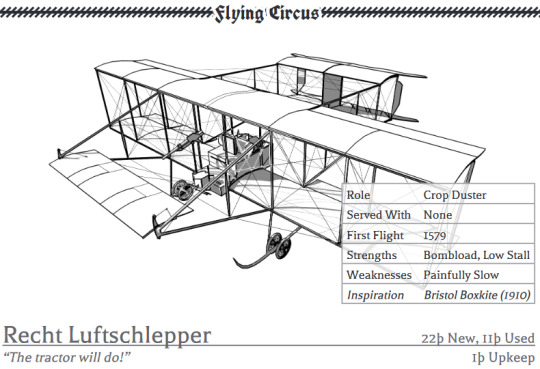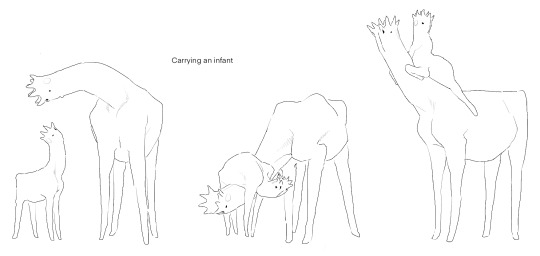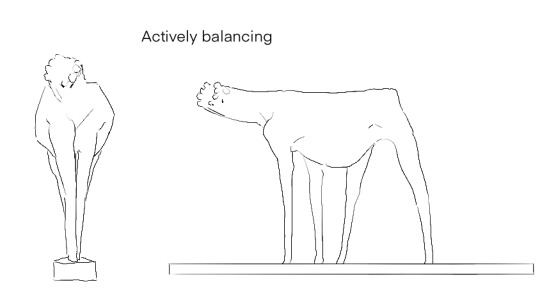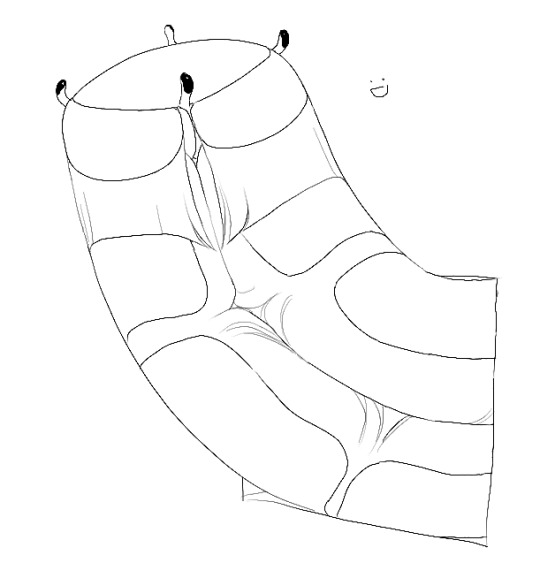#boxkites
Explore tagged Tumblr posts
Text

How to hold a grocery bag
Note, the Boxkite won’t be moving very fast like this.
310 notes
·
View notes
Text

Doodled a bunch of spec-bio aliens as cartoon green aliens. Centaurs, avians, bug ferrets, and scuds by @jayrockin, crowns and boxkites by @charseraph, and birgs by @iguanodont.
#speculative biology#spec bio#alien#aliens#green alien#rtts centaurs#rtts avians#rtts bug ferret#rtts scuds#birgs#crowns#boxkites#my art#geez I already drew it small but tumblr made the quality even worse if you don’t click on it
131 notes
·
View notes
Text

@charseraph’s funny fellas
163 notes
·
View notes
Text
Recht Luftschlepper - "The tractor will do!"

Role: Crop Duster Served With: None First Flight: 1579 Strengths: Bombload, Low Stall Weaknesses: Painfully Slow Inspiration: Bristol Boxkite (1910)
Description:
A common civilian plane and likely to be the longest produced aircraft in the world, the Recht Air Tractor was designed from the ground up as an agricultural tool. With a heavy diesel engine, it can move surprising loads, making it adept as a transport, crop duster and topdressing, utility cargo mover, trade platform, and cloud seeding.
Though nobody would think of using this aircraft as a front-line combat machine, many have been pressed into this role over the years. Thanks to its surprising load capacity, it can carry a fair number of bombs a fair distance, so they were sometimes used in dangerous night bombing missions.
Nowadays, agricultural towns often count these machines among the forces their militia could potentially use, in an emergency, and a great many bush pilots got their start in ground attack by training to drop barrel bombs from an armed farm tractor.
5 notes
·
View notes
Text



The pioneering Scottish aviator Bertram Dickson was born in Edinburgh on 21st December 1873.
Dickson was the first British winner of an aviation contest and his skills as a pilot also led indirectly to the foundation of the Royal Flying Corps, the forerunner of the Royal Air Force. As we shall see, he also notched up an achievement that he certainly did not want.
It is baffling that more is not known about Dickson. Indeed, of his early life, family and schooling, as I have posted before, all that can be reported is that he was born in Edinburgh on this day in 1873, it’s not the only missing period of Bertram’s life though as I will explain, the man is a bit of an enigma.
By the age of 19 Bertram Dickson was assisting the geographer Sir Thomas Holdich in the Andes Mountains in a famous expedition that defined the border between Chile and Argentina. Dickson went to the Royal Military Academy from where he graduated in 1894, being commissioned as a second lieutenant in the Royal Artillery in November, 1894, before gaining promotion to lieutenant and then captain by November 1900. His service until then had taken in British East Africa, South Africa and Somaliland.
The following May there began the great mystery of Dickson’s life, but one which is easily explained.
He was seconded to the Foreign Office and promptly disappeared from the records for seven years.
There’s little doubt that Bertram Dickson became a spy, an early James Bond-type who by 1908 was a military attaché in what is now Eastern Turkey but was then part of the Ottoman Empire. Prior to then he had also written articles for geographical journals – a normal cover story for espionage activities
Early in 1910, Dickson learned to fly at the Henri Farman flying school in France. Having gained his aviator’s certificate, No 71, the first British pilot from the services entered a flying contest and won it with the longest distance flown – believed to have been the first aviation endurance competition.
He repeated his success at air meetings in the UK – he won £400 at Lanark – before he resigned his army commission to work for the British and Colonial Aircraft company. It was while he was working for them that on September 21, 1910, Dickson flew his Bristol Boxkite aircraft in what were reconnaissance try-outs.
Dickson “won” the first sortie and was able to stress the importance of air war readiness to two observers, Field Marshal Lord Kitchener and Home Secretary Winston Churchill who was hugely impressed and would later be Secretary of State for Air.
Dickson then earned an unwanted distinction. On October 3rd, 1910, he was involved in the world’s first mid-air collision between two powered aircraft. He and the French pilot Rene Thomas survived the accident – for which the courts later blamed Dickson – but the Scot was very seriously injured.
Even as he lay in recuperation, Dickson made his greatest achievement, which was to persuade the Government to take war in the skies seriously. Kitchener and Churchill had not forgotten Dickson’s demonstration and as a result of their intervention, in November 1911, the then prime minister Herbert Asquith asked the Imperial Defence Committee to form an investigation into war in the air.
The Technical Sub-Committee for Imperial Defence duly inquired into the subject and it was to that subcommittee that Dickson made this prophetic submission: “In case of a European war, between two countries, both sides would be equipped with large corps of aeroplanes, each trying to obtain information on the other... the efforts which each would exert in order to hinder or prevent the enemy from obtaining information... would lead to the inevitable result of a war in the air, for the supremacy of the air, by armed aeroplanes against each other. This fight for the supremacy of the air in future wars will be of the greatest importance.”
Remember that this was before any country had an independent air force – pilots and planes were attached to army or navy units, and it was an Italian Army Air Corps flying French-built aircraft which first dropped bombs on Libya during the 1911-1912 Italo-Turkish war on October 23rd, 1911.
It may well have been that Dickson, with his connections to Turkey, had information on this first-ever air raid, and drew his conclusions accordingly.
The Imperial Defence Committee recommended the formation of the Royal Flying Corps which was instituted on April 13th, 1912, becoming the RAF six years later when it joined with the Royal Naval Air Service whose founding was largely the work of Dickson’s old contact, Winston Churchill.
Having never really recovered from his injuries sustained in the Milan air accident, Dickson died on September 28th, 1913, at Lochrosque Castle near Achnasheen in Ross-shire. He was buried in the Cnoc na Bhain burial ground in Strath Bran. There is a plaque honouring him nearby.
15 notes
·
View notes
Text

1912 postcard of a Bristol Boxkite and Airship Gamma II over Stonehenge.
0 notes
Text
The Milk Carton aka Boxkite House: Saturday W15Y3

View On WordPress
0 notes
Photo


( via / via )
𝘌̰̾𝘝̰̾𝘌̰̾𝘙̰̾𝘠̰̾𝘋̰̾𝘈̰̾𝘠̰̾ 🌀.
"And mouth[e]s his words at earless owls" --de Esque
Celestial rose.
"studio audience"
faffling gawks teach me beachhead in a boxkite topaz calcite ring
i carry through snowstorms
Boom.
0 notes
Photo










Biscuit boxkite, Isoxya tabulata, Araneidae (orbweavers)
Found throughout southeastern Africa
Photo 1 by tshahan, 2-3 by wynand_uys, 4-5 by alexanderr, 6-7 by suncana, 8-9 by wynand_uys, and 10 by bushboy
#animals#curators on tumblr#bugs#arachnids#spider#orbweaver#biscuit boxkite#one nice bug#losing my mind about these square ladies#incredibly shaped#also can we talk about the name#who is responsible for that#i believe this counts for#flat f*ck friday
3K notes
·
View notes
Video
Bristol Boxkite Replica 'No12A' (G-ASPP) by Alan Wilson Via Flickr: c/n BOX.1 Allocated British Aircraft Preservation Council identity BAPC.2 This is an accurate reproduction of a 1910 design, built in 1964 for the movie 'Those Magnificent Men in Their Flying Machines' and now operated by the Shuttleworth Collection. She is seen displaying at the collection’s 2022 Season Premiere Air Show Old Warden, Bedfordshire, UK 1st May 2022 The following information is from a previous version of the Shuttleworth Collection website:- In 1910 the British and Colonial Aeroplane Company at Bristol imported a Voisin designed Zodiac biplane from France with the intention of building similar aircraft under licence in England. Although superbly finished the aeroplane was never flown successfully and plans to build the design were abandoned in favour of a greatly improved version which had been developed by Henri Farman, an Englishman living in France. The new Bristol machine was an unashamed copy of the Farman but rather better built so that when the Farman company solicitors threatened to sue a defence claiming substantial improvements ensured that no court proceedings took place. Following trials with alternative power plants, the 50 hp Gnome rotary engine was adopted and the aircraft flew successfully from Larkhill in July 1910. The Bristol biplane soon gained the soubriquet and equipped the newly formed flying schools at Brooklands and Larkhill. Later, in December 1910, four were shipped in pairs on air missions to India and Australia . However, the first order from overseas was placed by the Russian Government for eight Boxkites and they were delivered to St Petersburg in April 1911. These aircraft,military versions, had extended upper wings, three rudders, enlarged fuel tanks and more powerful 70 hp Gnome rotary engines. The Boxkite was issued to the Royal Naval Air Service in March 1911 and to the Larkhill based Army Air Battalion the following April. Some seventy-six Boxkites were built, which was a large number for the period. However, they proved cumbersome to fly and, by 1915, the majority had ceased to operate. This aeroplane is a reproduction built by F. G. Miles Engineering Ltd in the 1960s for the film Those Magnificent Men in Their Flying Machines. As no original Boxkite exists, the Bristol Aeroplane Company acquired it and placed it in the care of the Collection for preservation. In 1989 the aircraft was modified to improve a number of handling characteristics and is now powered by a Rolls-Royce Continental four cylinder engine of 100 hp. (The greater power of the modern engine is cancelled out by the smaller, higher revving modern propeller which, perhaps surprisingly, does not provide the same thrust as the seemingly lower powered 1910 design.) It flew again in 1992. Like the Blackburn Monoplane, its flying activities are subject to calm weather on public displays.
3 notes
·
View notes
Text






Prompts
2K notes
·
View notes
Video
instagram
Drum Heads Fan Feature! 🥁• @mattdavisdrum @lpmusicofficial #boxkit @dwdrums @innovativepercussion @drumsoulet @drumsharing @drummunity @alldrummers @drummers_corner_group @merrell @theboxkit #drumheadspod #drum #drums #drummer #thedrumheadspod #percussion #music #musician #drumming #drumfam #bateria #drumlife #drummerlife #instadrums #drumcommunity #drumsharing #drumsoutlet #drummerscorner #dg2g #snaredrumfreakz #drumlads #drumsdaily #drumset #drumsetup #drumporn https://www.instagram.com/p/B4G3lE1FAqT/?igshid=qqv2pedpi194
#boxkit#drumheadspod#drum#drums#drummer#thedrumheadspod#percussion#music#musician#drumming#drumfam#bateria#drumlife#drummerlife#instadrums#drumcommunity#drumsharing#drumsoutlet#drummerscorner#dg2g#snaredrumfreakz#drumlads#drumsdaily#drumset#drumsetup#drumporn
2 notes
·
View notes
Photo

Box Kite + Golden Teachers 30 X 22” acrylic / collage on panel 2022 #studiofuel #collage #boxkite #goldenteacher #mushrooms (at Williamsburg, Brooklyn) https://www.instagram.com/p/CYpCwACl_4N/?utm_medium=tumblr
1 note
·
View note
Text
I also think it's funny that the others (vampire mikey excluded) wore grey wigs, they let their hair show their age but gerards wig is shiny boxkit-dye black. He's playing the desperate showman, the frontman clinging on the hardest of the band cuz the spotlight was always on him and what he did with his hair. He never really had natural hair on the magazine covers. There were ppl in that audience that probably don't even know its brown.
407 notes
·
View notes
Photo

Meet Audrey, my big-ass #boxkite. Yes, I'm wearing #gloves. She's as wide as I am tall and I swear to you she almost pulled me over once. But she's a good kite. #windyassdayinkansascity (at Lees Summit, Missouri) https://www.instagram.com/p/CNQrriVJyeI/?igshid=ldwfx1onovrk
0 notes
